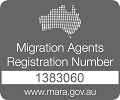Offshore partner visas – subclass 309 and subclass 100
To apply for an offshore partner visa, the visa applicants must be outside Australia when the visa application is lodged.
The application is a combined application for a temporary Class UF Subclass 309 Partner (Provisional) visa and a permanent Class BC Subclass 100 Partner (Migrant) visa.
For the visa to be granted, the visa applicants also must be outside Australia when the Department of Home Affairs grants the temporary offshore partner visa.
People who apply for an offshore partner visa do not get a bridging visa. However, they are free to apply for another visa such as a visitor visa to spend time in Australia while the partner visa application is being processed.
Onshore partner visas – subclass 820 and 801
Not all people are eligible to apply for an onshore partner visa. To be eligible to apply for an onshore partner visa, the visa applicants must already be in Australia on a visa that does not have a ‘no further stay’ condition.
A no further stay condition, condition 8503 or 8531 on visitor visas or condition 8534 or 8535 on student visas, bars the visa holder from being granted for another visa while they remain in Australia (except a protection / humanitarian visa or certain student / graduate visas for existing student visa holders).
People from countries that the Department of Home Affairs considers to be ‘high risk’ are often not able to get a visitor visa or student visa to come to Australia.
People from medium-risk or high-risk countries who are granted a visitor visa, will often have no further stay condition 8503 on their visitor visa. These people are not eligible to apply for an onshore partner visa. Their only option is to apply for an offshore partner or prospective marriage visa, or to apply for another visitor visa in future to see if they are granted one without condition 8503.
To apply for an onshore partner visa, the visa applicants must be in Australia when the visa application is lodged.
The application is a combined application for a temporary Class UK Subclass 820 Partner (Temporary) visa and a permanent Class BS Subclass 801 Partner (Residence) visa.
For the visa to be granted, the visa applicants also must be in Australia when the Department of Home Affairs grants the temporary onshore partner visa.
People who make a valid application for an onshore partner visa are granted a bridging visa that lets them stay in Australia (and in most cases work in Australia) while the partner visa application is being processed.
Should we choose an offshore partner visa or onshore partner visa?
For couples who have the option to apply for either an onshore or an offshore partner visa, the best visa option will depend on where they plan to live for the next 2 years while the partner visa application is being processed.
Most couples who can apply for an onshore partner visa choose the onshore option because it lets them live together in Australia while the partner visa application is being processed. As at 18 July 2019 75% of subclass 820 temporary onshore partner visa applications are being processed within 22 months.
One disadvantage of onshore partner visa applications is that after the visa applicants’ previous visa ends, the applicants will be on a bridging visa that does not let them leave Australia until the temporary partner visa is granted. Visa applicants who hold a bridging A visa (automatically granted to people who apply for an onshore partner visa whilst holding a non-bridging visa), can later apply for a bridging B visa with a temporary travel permission if they can show a “substantial” reason for leaving the country while their onshore partner visa application is being processed.
The offshore partner visa option suits some couples who are not yet ready to move to Australia for personal reasons. For example, people who have employment commitments or are winding up a business in their home country or couples that plan to give birth to a child in their home country before they migrate to Australia.
Offshore partner visa processing times are currently shorter. As at 18 July 2019 75% of subclass 309 temporary offshore partner visa applications are being processed within 15 months. However, visa processing times vary from case-to-case and processing times are expected to increase. Living with the uncertainty of not knowing exactly when the visa to migrate to Australia will be granted can become very stressful.
Offshore partner visas also have a higher refusal rate than onshore partner visas, especially for couples who are living apart during the processing of an offshore partner visa application. For these couples, it is crucial to prove that they are maintaining their relationship during time spent apart. For example, proof of overseas travel to visit each other and proof of regular phone or internet contact during time spent apart.
Registered migration agents who specialise in partner visas can give advice about partner visa eligibility and which partner visa option is best for you.


